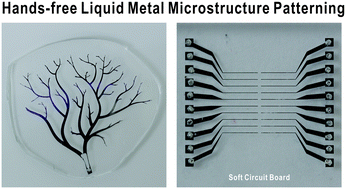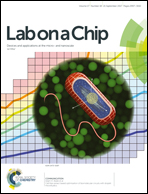Vacuum filling of complex microchannels with liquid metal†
Abstract
This paper describes the utilization of vacuum to fill complex microchannels with liquid metal. Microchannels filled with liquid metal are useful as conductors for soft and stretchable electronics, as well as for microfluidic components such as electrodes, antennas, pumps, or heaters. Liquid metals are often injected manually into the inlet of a microchannel using a syringe. Injection can only occur if displaced air in the channels has a pathway to escape, which is usually accomplished using outlets. The positive pressure (relative to atmosphere) needed to inject fluids can also cause leaks or delamination of the channels during injection. Here we show a simple and hands-free method to fill microchannels with liquid metal that addresses these issues. The process begins by covering a single inlet with liquid metal. Placing the entire structure in a vacuum chamber removes the air from the channels and the surrounding elastomer. Restoring atmospheric pressure in the chamber creates a positive pressure differential that pushes the metal into the channels. Experiments and a simple model of the filling process both suggest that the elastomeric channel walls absorb residual air displaced by the metal as it fills the channels. Thus, the metal can fill dead-ends with features as small as several microns and branched structures within seconds without the need for any outlets. The method can also fill completely serpentine microchannels up to a few meters in length. The ability to fill dense and complex geometries with liquid metal in this manner may enable broader application of liquid metals in electronic and microfluidic applications.



 Please wait while we load your content...
Please wait while we load your content...